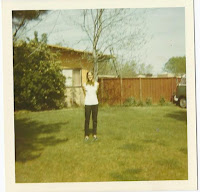Since I’ve already spoken of my childhood visit to British
Columbia, I can’t wax nostalgic about Canada, so I’ll have to talk of my
girlhood in a small town in California.
I grew up in the village of Pacheco, which had been an
important place in the 1800’s, a commercial center with access to shipping. But
by the time I came along, in the 1950’s, it was a tiny town with a mom and pop
grocery store, a candy store, the Pacheco Inn (a bar), drug store, and the
bowling alley. Of all those places, only the bowling alley is left.
Pacheco is twenty-seven miles north-east of San Francisco.
My wonderfully flamboyant Aunt Mary lived in that great metropolis, so when my
family visited her my brother and I spent many days roaming the city, riding
cable cars and exploring Fisherman’s Warf.
 |
| Brother, Scott |
Surrounded by farms in Pacheco, we lived in Country Club Homes, which
sounds much grander than it actually was. It’s tract homes with cookie-cutter
houses on asphalt roads. No wonder in my novels I write about quant
half-timbered cottages on crooked, cobbled lanes.
Our life was still quite rural. We kept pigeons on the roof, chickens in the yard, and sheltered
stray cats with kittens in cardboard boxes.
 |
| Best friend Candy, and author, 1964 |
My friends and I rode our own horses along the country
roads, and into the fields, racing through landscape now built up with houses.
The hills above Pacheco were lush, green and full of grazing cows—now
condos scar the landscape.
A creek flowed through the town and on into the next, with a dirt road on both sides. We once played with snapping crawdads in the summer and watched tiny frogs emerge like a marching army.
The creek is filled in today, no trace left.
We attended the local elementary school, a rambling pink stucco structure now torn down. Below is the mural I helped to draw of our school when I was in sixth grade.
We attended the local elementary school, a rambling pink stucco structure now torn down. Below is the mural I helped to draw of our school when I was in sixth grade.
I’m not sad (well sometimes) about these changes, only
disappointed for the children currently growing up there . I know life must move forward, but I’m grateful I lived my childhood when I
did, when it was wild and rural.
 |
| Author at sixteen, front yard of childhood home, 1970 |
To find out more about Diane Scott Lewis and my novels, please visit my BWL Author page
or my website: dianescottlewis.org



Sounds like an ideal childhood, Diane. Much like mine. I feel sorry for children today who don't have that kind of freedom. Nice to learn more about you and what informs your great stories.
ReplyDeleteYou touch on what makes each author's book different than any other, the writer's history. Where they grew up, and the people that shaped who they are and who they want to be. Finding that common ground in readers is the one thing all writer's attempt to do. You as a writer do that very well by drawing the reader into the story with your vivid descriptions.
ReplyDeleteNow, reading your stories we have something in common besides just writing fiction. You grew up in California. I grew up in Iowa. And we both had chickens running in our front lawns.
thanks, Lisa and Maggi for your comments! I'm glad you enjoyed my post.
ReplyDeleteThank you for sharing this glimpse into the past.
ReplyDeleteWhat a great childhood you had. Thanks so much for sharing.
ReplyDeleteQuite fascinating - I had no idea that your background was like this. It sounds a lovely way to grow up compared with children who have no contact with nature, or with peace and quiet. Thank you.
ReplyDelete